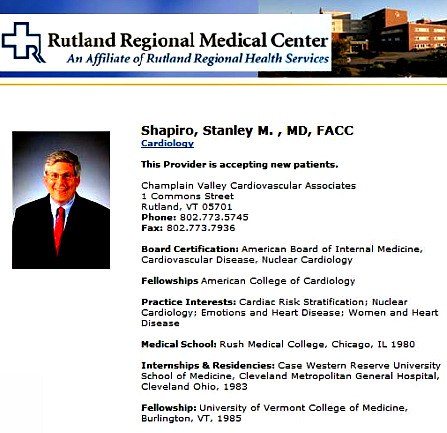"A recent piece I wrote on the cardiac consequences of sleep deprivation has been accused of fear-mongering on wind turbines" (Vermont)
Feb 1, 2010
—Stan Shapiro, MD, Rutland Herald (2/1/10)
A recent piece I wrote in Heart Health News on the cardiac consequences of sleep deprivation has been accused of fear-mongering on wind turbines. I wish to address several of the author’s comments and correct them.
First, the work is entirely my own and does not represent an opinion nor position of Rutland Regional Medical Center. I understand that the medical center will host a balanced forum on Health Issues of Wind Turbines in the spring. Additionally, a group of Rutland area physicians have a committee to study the health impacts of wind turbines. This is laudatory, and the people of Rutland County should be proud their institution and area physicians are willing to study difficult issues that affect health.
Personally, I stand by the facts of the article. Sleep deprivation is harmful to one’s health. It imposes psychological, physiological, and health effects that have morbid consequences. I argued in the Heart Health piece that increased morbidity leads to increased risk of mortality. This is a medical axiom that is clearly supported in the cardiology literature.
Preliminary findings in Mars Hill, Maine, conclude that adults living within 1,100 meters of industrial wind turbines suffer higher incidences of chronic sleep disturbance compared to a control group 5,500 meters away. In Japan 90 percent of complaints against wind turbines have been health-related, with insomnia being among the leading concerns.
The AWEA-CANWEA [report] that is cited by the author is said to rebut the “myths” I put forward. This paper barely addresses sleep deprivation and does not deal with the facts I advanced. This industry-financed paper did not study wind turbine health effects, it merely reviewed available literature, and nowhere does it interview one person whose life has been turned asunder living in proximity to industrial wind turbines.
The intersection of health and renewable energy is a brand new area of medical inquiry that must be studied. To say that no further study of the issues is necessary, as the AWEA-CANWEA authors did, is shameful. The precautionary principle must be applied to projects that have the potential of worsening our lives. I and others will continue to work unceasingly on issues we believe in.
I am thankful that RRMC is an institution whose culture encourages dealing with hard, complex issues in a robust and learned manner, and where dissent can be embraced as one of the building blocks of further understanding and growth. RRMC is an organization with integrity. I am hopeful that my studied position on this important issue will be seen for what it is, and not as a position of RRMC.
·



Comment by Rural Grubby on 02/01/2010 at 3:01 pm
Great news! Finally people are coming out and questioning the convention as well as trying to fully understand the work of Dr. Pierpont and Dr Nissenbaum. It takes great courage to do this especially when, so often, one’s position or “job” is at stake due to society’s fervent ideology which is pushing the green madness all around us. I am so tired of hearing that things such as Industrial wind turbines provide, clean, green and free power. Nothing could be further from the truth if people would just take the time to investigate. To top things off, those who suffer from having these monstrosities near their homes, are being ridiculed and labelled as psychosomatic. Because of this, so many would rather suffer in silence rather then bear the isolation and controversy resulting from coming forward. It is all so overwhelming and the burden ends up lying on the shoulders of good people such as Dr. Pierpont and now luckily Dr. Shapiro. Your perseverance is much appreciated. Thank you